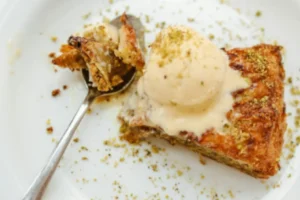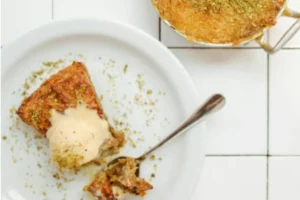Introduction Flavors of Christmas Baklava
The Festive Flavors of Christmas Baklava
Baklava has long been synonymous with celebrations and indulgence. Its mere mention conjures images of golden layers of phyllo pastry, generously filled with nuts and drenched in honey. But what sets Christmas Baklava apart is its unique blend of flavors, infused with the essence of the holiday season. Imagine biting into a piece of this exquisite dessert, greeted by the warmth of cinnamon, the earthiness of cloves, and the citrusy zing of orange peel. Each bite is a symphony of tastes, a harmonious union of sweetness and spice that dances on the palate.
Unraveling the Tradition
At its core, Christmas Baklava is more than just a dessert; it’s a symbol of togetherness and tradition. Across various cultures, the act of preparing and sharing baklava during the festive season is steeped in symbolism. It signifies abundance, prosperity, and the joy of communal gatherings. Families come together in the kitchen, passing down age-old recipes from generation to generation, ensuring that the spirit of the season is preserved in every decadent layer.
Tracing the Origins
History is a tapestry woven with threads of tradition, and the origins of Christmas Baklava are no exception. Dating back centuries, the roots of this beloved dessert can be traced to the ancient lands of the Middle East. It is said that early versions of baklava were enjoyed by the royalty of the Byzantine Empire, who relished its decadent layers as a symbol of their opulence and wealth.
An Ancient Treat
The earliest known recipe for a dish resembling baklava can be found in the 10th-century Arabic cookbook, Kitab al-Tabikh (The Book of Dishes). Here, layers of dough are filled with nuts, honey, and rose water, offering a glimpse into the dessert’s humble beginnings. Over time, as trade routes expanded and cultures collided, baklava evolved, incorporating new ingredients and techniques from the lands it encountered.
Influences from Various Regions
As the centuries unfolded, baklava spread its wings, journeying across the Mediterranean and beyond. In Greece, it became a staple of Orthodox Easter celebrations, while in Turkey, it was elevated to an art form, with intricate layers of phyllo pastry meticulously crafted by skilled hands. Each culture infused its own unique flavors and traditions into the dessert, transforming it into a symbol of cultural exchange and culinary innovation.
The Key Ingredients

Nuts, Honey, and Phyllo Pastry
Nuts form the crunchy core of baklava, adding depth and richness to every bite. Traditionally, a mixture of walnuts, pistachios, or almonds is used, though regional variations may incorporate other nuts such as cashews or pecans. These nuts are finely chopped and layered between sheets of delicate phyllo pastry, which provide a crisp contrast to the soft, nutty filling.
Honey acts as the sweet glue that binds the layers together, infusing the dessert with a luscious, golden sweetness. Drizzled generously over the assembled baklava, honey seeps into the pastry during baking, creating a sticky glaze that caramelizes beautifully.
Regional Twists and Special Additions
While nuts and honey form the backbone of Christmas Baklava, each region adds its own unique twist to the recipe. In Greece, for example, baklava may be flavored with cinnamon and cloves, imparting a warm, spicy note to the dessert. In Turkey, a hint of rose water or orange blossom water may be added to the honey syrup, lending a floral aroma to the finished dish.
Crafting the Perfect Dessert
Step-by-Step Guide
- Prepare the Nuts: Start by finely chopping your selection of nuts. Aim for a mixture of textures, with some pieces finely ground and others left slightly chunky for added crunch.
- Layer the Phyllo Pastry: Brush a baking dish with melted butter, then layer sheets of phyllo pastry, brushing each layer with butter as you go. Aim for around 6-8 layers to create a sturdy base for your baklava.
- Add the Nut Filling: Sprinkle a generous layer of chopped nuts evenly over the phyllo pastry. Press down gently to compact the filling and ensure even distribution.
- Repeat the Layers: Continue layering phyllo pastry and nuts until you’ve used up all your ingredients, finishing with a final layer of pastry on top.
- Cut and Bake: Using a sharp knife, carefully cut the unbaked baklava into diamond or square shapes. This will make it easier to portion once baked. Bake in a preheated oven until golden brown and crisp, usually around 40-50 minutes.
- Drizzle with Syrup: While still warm from the oven, pour a generous amount of honey syrup over the baklava, allowing it to seep into the layers. Let the baklava cool completely before serving to allow the flavors to meld together.
Tips for Success
- Use Quality Ingredients: Opt for fresh, high-quality nuts and honey for the best flavor.
- Handle Phyllo Pastry with Care: Phyllo pastry can be delicate, so work quickly and gently to avoid tearing.
- Let it Rest: Allow the baklava to sit for a few hours or overnight before serving. This allows the flavors to fully develop and the syrup to soak into the layers.
Serving Up Festive Cheer
Plating Like a Pro
- Garnish with Flair: Sprinkle a handful of finely chopped nuts over the top of your baklava for an extra crunch and visual appeal.
- Dress to Impress: Drizzle additional honey over the plated baklava just before serving, creating a beautiful glaze that glistens in the light.
- Add a Touch of Freshness: Serve your baklava with a side of fresh berries or a dollop of whipped cream for a refreshing contrast to the rich sweetness of the dessert.
Pairing Suggestions
- Hot Beverage Pairings: Pair your Christmas Baklava with a steaming cup of coffee or hot chocolate for a cozy treat on a cold winter’s day.
- Ice Cream Delights: For a decadent dessert experience, serve your baklava alongside a scoop of vanilla ice cream or clotted cream.
- Fruit Infusions: Accompany your baklava with a glass of mulled cider or pomegranate juice for a refreshing burst of flavor.
Indulgence with Benefits
While Christmas Baklava may be a decadent treat, it also offers surprising health benefits when enjoyed in moderation. In this section, we’ll explore the nutritional value of baklava and consider some dietary considerations for those with specific health needs.
Nutritional Value
- Rich in Nutrients: Nuts, the primary ingredient in baklava, are packed with essential nutrients such as healthy fats, protein, fiber, vitamins, and minerals.
- Antioxidant Properties: Honey, another key component, contains antioxidants that may help protect against cell damage and inflammation.
- Moderate Portions: While baklava is nutrient-dense, it is also calorie-dense, so it’s important to enjoy it in moderation as part of a balanced diet.
Moderation and Dietary Restrictions
- Portion Control: Enjoying a small serving of baklava as an occasional treat can fit into most dietary patterns, including Mediterranean and MIND diets.
- Allergen Considerations: Individuals with nut allergies should exercise caution when consuming baklava, opting for nut-free versions or alternatives made with seeds or dried fruits.
- Dietary Modifications: For those with dietary restrictions, there are many creative ways to adapt baklava recipes, such as using gluten-free phyllo pastry or substituting honey with maple syrup for a vegan option.
FAQs About Christmas Baklava
- Interesting Facts about Baklava:
- Baklava is believed to have originated in the ancient Assyrian civilization around 8th century B.C.
- The word “baklava” is of Turkish origin, derived from the word “baklava” meaning “to tie” or “to wrap”.
- Baklava was considered a food of the wealthy and royalty in the Ottoman Empire, and it was often served during special occasions and celebrations.
- There are many variations of baklava across different cultures, with each region adding its own unique twist to the recipe, such as different types of nuts, spices, and syrups.
- Is Baklava Eaten at Christmas?
- Yes, baklava is often enjoyed during Christmas celebrations in various parts of the world, particularly in Greece and Turkey. It is a popular dessert choice for holiday feasts and gatherings, where it is served alongside other traditional sweets and delicacies.
- Cultural Significance of Baklava:
- Baklava holds deep cultural significance in many cultures, symbolizing hospitality, generosity, and celebration.
- In Middle Eastern and Mediterranean cultures, offering baklava to guests is a gesture of hospitality and goodwill.
- In Greece, baklava is often served during special occasions and religious festivals, symbolizing prosperity and abundance.
- Why Does My Baklava Fall Apart?
- Baklava may fall apart if it is not properly assembled or if the layers of phyllo pastry are too dry or too thick.
- To prevent baklava from falling apart, make sure to brush each layer of phyllo pastry with melted butter or oil to keep it moist and pliable.
- Additionally, make sure to press down gently on each layer of nuts to ensure they adhere to the pastry and hold the baklava together.
FOR MORE RECIPES CLICK HER


